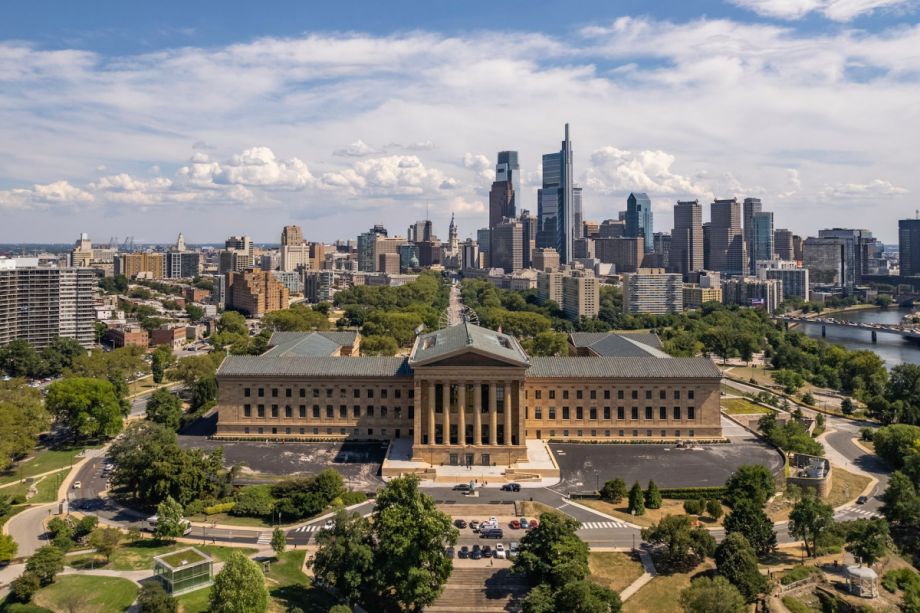This story was originally published at Prism.
On Oct. 14, unionized employees at the Philadelphia Museum of Art (PMA) achieved a monumental contract victory with museum management, ending a 19-day strike. The tentative agreement, which runs through June 30, 2025, raised the hourly minimum wage, reduced health care plan costs, provided across-the-board wage increases and paid parental leave, and instituted the museum’s first ever longevity raises. Following this victory, union members are hopeful that their efforts may help reshape the museum industry as a whole.
“There were 5 issues going into the strike. We got all 5,” the PMA Union posted on Twitter Oct. 14. “Management claimed they wouldn’t move. They did.”
The union first formed in 2020, when PMA employees voted overwhelmingly to join the American Federation of State, County, and Municipal Employees. Shakerra Grays, the Interactive Project Manager for PMA, said that employees unionized “in response to physical, verbal, and sexual harassment that went ignored by museum leadership.” One such case included that of a male manager’s harassment of several women on staff.
Though the PMA union is one of the country’s largest museum unions, management failed to respect it at first, trapping the union in negotiations for two years. This came to a head on Aug. 26, when union leadership filed eight Unfair Labor Practice charges against museum management, accusing the PMA of repeatedly engaging in union-busting activity during contract negotiations. A few weeks later on Sept. 16, union leadership launched their initial warning strike, demanding more reasonable health care costs, parental leave, a minimum wage pay increase to $16.75 an hour, incremental raises, and longevity increases for staff over five years.
“We honestly just wanted to be able to have a basic standard of living where we don’t need second jobs to pay for rent and groceries,” said Karen Conway, coordinator of events and dining at PMA. However, when museum leadership failed to meaningfully address the warning strike and Unfair Labor Practice charges, nearly 200 museum workers began what would become their 19-day strike on Sept. 26, coinciding with the first day of PMA’s new director and CEO, Sasha Suda.
According to Art News, museum leadership stated in a press release that it “respects the rights of employees” to strike, though it also expressed “disappointment” in the union’s decision “despite the significant wage increases and other offers made by the museum at the last negotiating session.” For workers like Conway and Grays, PMA’s initial response to the strike brought about a whirlwind of emotions, including their own disappointment.
“What we were asking for was literally pennies,” said Conway. “[It’s disappointing] to think that a board met and decided that we weren’t worth that, but the cost of the same anti-worker lawyer firm that McDonald’s and Amazon use was.”
While the museum’s initial response was lackluster, Philadelphians were quick to offer their support. Democratic state Sen. Nikil Saval tweeted on the first day of the strike, “When workers hold their ground and ask that their labor be respected, they’re holding the line not just for themselves but for all workers, everywhere. Philly is a union town.” Shortly after on Sept. 30, City Councilmember Helen Gym also expressed support from the picket line, writing, “Proud to stand with the @PMA_Union workers this morning.” With this encouragement, museum workers stood their ground even as the strike stretched for weeks.
“To feel seen, heard, and supported went a long way to helping us stick together, stay the course, and win,” said Grays.
As the strike continued, workers like Conway expressed conflicting emotions of empowerment and fear. “I thoroughly enjoyed getting to know coworkers I wouldn’t have normally interacted with on the line,” said Conway. “But let’s face it: Strikes are nerve-wracking. The anxiety about work piling up, finances if this held out longer than a month, or potentially having to find another job was a constant thought.”
When union president Adam Rizzo finally announced a tentative agreement with museum leadership, Grays, who was on the picket line, said, “I was so relieved and incredibly proud of what we’d accomplished as a union. I shed tears. I hugged my colleagues. I called my mom.”
As part of the new contract, the minimum wage for PMA workers will be raised from $15 to $16.75. Employees will also receive six across-the-board pay increases over the three-year agreement, totaling 14% and an increased minimum for salaried employees from $38,000 to $42,000. In addition, employees will receive four weeks of paid family leave, and bonuses for employee longevity, among other wins.
“We believe that the staff of the PMA is the foundation of the museum’s future,” museum director and CEO Suda said in a press release. “Unions can work in partnership with management to ensure that a thriving institution is also a safe and sustainable employer.”
Although the strike is over, union workers want others in the industry to see it as inspiration. “I hope this strike sends a message to all arts workers that they matter,” Grays said. “That they deserve to do what they love and be fairly compensated for it … I hope that we’ve shown that no one ever had to settle for less. And no one should do so ever again.” Workers also hope that this victory will pave the way to advocating for systemic change that extends beyond performative diversity and equity initiatives or awkward, out-of-touch ice cream socials.
“Overall, I hope we quickly move away from bloated, top-heavy compensation plans that pay executives large salaries with no justification, but nickel and dime [those] maintain[ing] the day-to-day operations of an institution,” said Grays. “I want to see this industry disrupted. We will all be better for it.”
Vanessa Taylor is a freelance reporter in Philadelphia. They are a former reporter for Mic News and the founder of Nazar, an independent journalism project on surveillance.
















